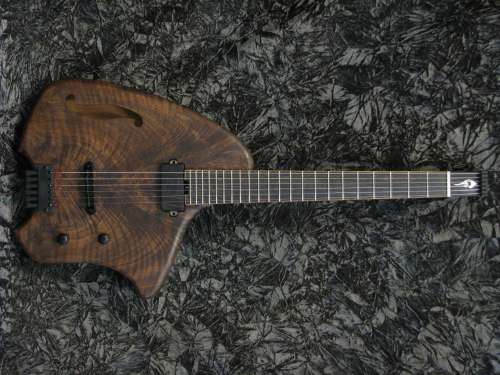A Walnut Beauty from Chris Forshage
This recent electric guitar by luthier Chris Forshage features a gorgeous walnut body and a Gibson Birdland scale 23.5″ neck.

In keeping with his Forshage ergonomic guitar design, it’s a hollow body with ABM bridge hardware. While the original design is already light weight at roughly 6 lb, Chris describes this one as “more hollow than usual”. The result is a guitar weighing right around 5 lb – just the thing for aching backs!
Mother of… wow. I really thought I was all GASsed out on electric guitars, and I already have a Forshage. Whose beauty is that, and how did you get the pic?
Beautiful bookmatching of the walnut on the top! Single humbucker in the neck, I bet that is a sweet sounding jazz toned guitar.
Incredible! Speaking of aching backs. Having it right now. Slipped disc, not due to guitar playing though. That guitar looks like a stealth aircraft or something. Very very cool. Looks dangerous if you’d ask me.
Wow, she is a beauty! Different finish, too — is it oiled or a “satin” finish or something? The scale seems SO short! Actually, it would be perfect for my son, who’s just starting guitar.
Marc
I’m glad to see a short scale. I think that too often we ignore scale length when looking at ergonomics. Playing some of the tough chords on a 25.5″ scale can be stressful on the hands. I’ve been looking into shortscale instruments for a while now, but there aren’t too many choices in the guitar world.
@Grand Weepers – Agreed on the value of short scale guitars in terms of ergonomics. Shorter scales, lower tension etc. Alternately, a long scale neck could be capo’d and retuned. But I would like to see some short scale necks as part of some of the ergo builds as well.
So who owns this thing so we can bug him/her for details and clips??
@Roger, Marc, Al – I believe answers are coming… 🙂
Oh yeah I remember that one. belongs to Chris Cartledge in South Carolina. That guitar plays so easy and sounds like a piano. I was expecting some tonal sacrifices with the short scale but there were none. So much fun to play. The finish is Tru-oil, a gunstock finish that can be found at Academy. The pickup is a Benedetto B-7 with a real ebony veneer glued to it. I miss it!
Short scale vs long scale. Here we go. How about multiple scale? I e fanned frets? The thinnest strings at shorter scale than the bass strings. Hold up your fretting hand in front of you and spread your fingers, how does that look?
How about an article on if fanned frets has ergonomic benefits or not? I’ve tried a bass, and at least on 5 string, it felt better and sounded far more better. But it has to be long scale at the low bottom.
Thing with fanned frets, is that on a guitar, I think it’s imposign a few limitations regarding bending strings in certain places. Bending a string when the fret wire starts to go THE OTHER WAY makes it either go down in pitch, or STAY in pitch or not go up as much.
@Mats – I’d love to do an article on whether fanned frets have ergonomic benefits. However, I’ve never had access to one and several previous inquiries have been indeterminate.
You mentioned it feeling better. Was this in classical fretting position or a rock position? Did it make a difference?
Oh and thanks for the observation on string bending behavior. It’s the first time I’ve heard it mentioned.
@Mats/Robert: Ralph Novak, one of the better known users of the fanned fret design (no, he did not “invent” it, but he certainly has refined the practice) is quite knowledgeable and usually quite willing to chat about the benefits of the fanned frets. I’m sure he could answer questions about the true ergonomic reality of the design (as well as the physics behind it). I’ve played some of Ralph’s guitars, and they feel and sound wonderful. At first, though, you have to look away from the fretboard, or visually you get confused! Otherwise, the fanned frets are very natural feeling.
I’ve also learned from other fanned fret builders that to get the full benefit of the design on a 6-string guitar, you actually need the scale to be 25″ – 27″ (from high to low strings, respectively).
Anyone out there play one as their main guitar??
Marc
@Marc – Having read Ralph Novak’s transcript from a very interesting lecture on fanned frets, I realized he wasn’t focused on ergonomics. His focus was on tonal qualities. However, I briefly chatted with Ralph Novak about this last year and he didn’t make any specific claims about ergonomics and fanned frets.
So are they more ergonomic? Not having any experience with fanned frets, I can’t speak on the subject but it at least sounds like it doesn’t make things any more “difficult” for the guitarist.
Chris, is there a way I can contact you?
@John – You can reach Chris at info [AT] forshage [DOT] com.
Just change AT and DOT to the appropriate characters.
His site is forshage.com but he doesn’t have anything up on the ergo guitars at this time. You’ll also want to view it in Internet Explorer or Opera because Firefox doesn’t render the navigation menus on his site – including his contact link. I’ve made Chris aware of the issue.